Winter Gear Guide for Outdoor Nursery: For a warm and happy child!


This post contains affiliate links. As an Amazon Associate I earn from qualifying purchases.
Outdoor nursery is an appealing prospect in the summer, but in the winter it can be rather daunting! Keeping warm and dry makes all the difference. I’ve been doing outdoor playgroups or had children in outdoor nursery for five winters, so as a family we’ve had a lot of practice at layering up for winter weather! Over the years we’ve tried and tested a lot of winter clothing to hopefully keep the children toasty warm and comfortable for their adventures outside.
That being said, I am not an educational professional, so there may be aspects of the practicalities that I don’t see. The ideas in this gear guide are from one parent to another, with tips on durability, sizing, and finding something suitable on a budget.
In my experience, what you need for outdoor nursery is a bit different from what you need for, say, a frosty woodland walk. There will probably be a lot of mud. Children will want to use their hands for activities. They will need to stay warm and dry all day. And then they need their clothes to be ready to go again the next morning! Here are the things I am looking for when purchasing winter clothing for outdoor nursery:
- Easy cleaning is a top priority because your child may often be very muddy. You can put lots of shell layers through the washing machine, but I try to only do so occasionally as it can damage the waterproofing. So as much as possible, I look for outer layers that wipe clean easily.
- Outdoor nursery gear needs to be durable enough to cope with daily use.
- I like our nursery clothes to be quick drying where possible so that I don’t need to buy too many sets to get through the week.
- Children are often wearing the same brands for nursery so I like items that come in a range of colours to reduce the chances of having exactly the same hat or gloves as another child.
Here are my suggestions for winter outdoor nursery gear to cope with a range of conditions:
Base Layers
The first layer should be a skin-tight thermal layer to trap as much heat as possible. I look for designs with cuffs at wrist and ankle so that you can size up without annoying your child! Personally I prefer zip neck designs for easy on/off and warm necks.
This layer also includes a thin wool-blend sock. More on socks later!


Generally I find wool base layers to be the warmest, but I actually don’t tend to use them for outdoor nursery because they aren’t that robust, and tend to get holes and ladders with daily wear. I absolutely love the Didriksons Jadis synthetic base layers, which are warm and comfortable, come in a range of colours, and seem to last forever. I wash mine on Delicates 30 and sets we’ve used for over two years still look pretty much brand new, I’m so impressed with them. They also dry very quickly. I do balk at the price, but they can often be found half-price in the spring and summer, so keep an eye out!
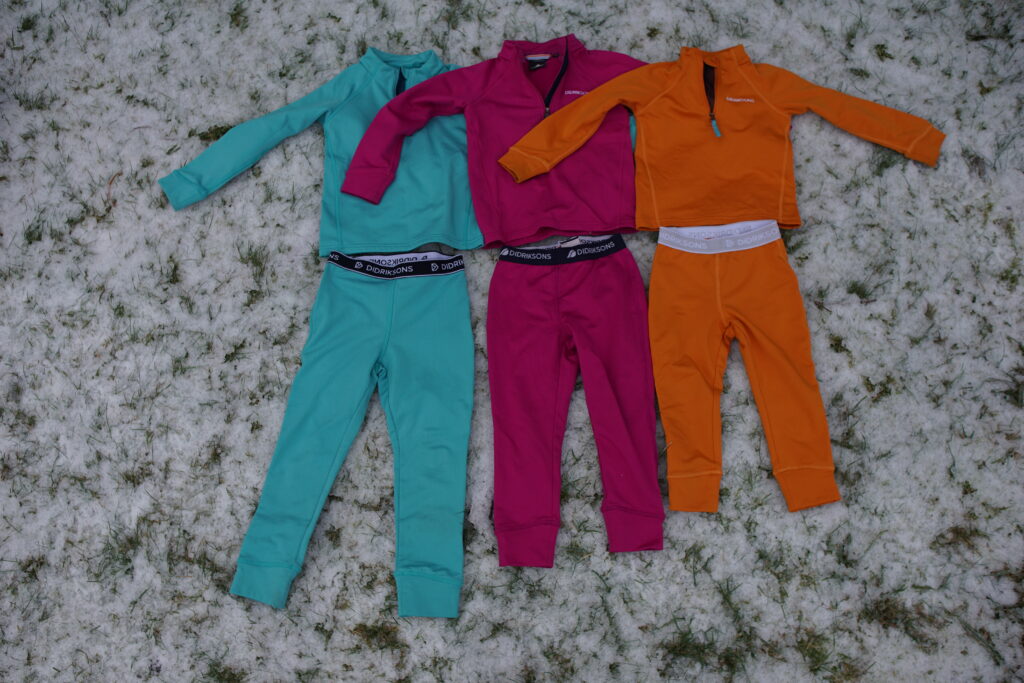

On very cold days (below freezing all day) I usually layer up with wool thermals underneath, just for my own peace of mind! But this is obviously more difficult for toilet trips.




Base layers top pick: Didriksons Jadis
Merino wool base layers: These are less robust but very warm for the coldest days. We have used Icebreakers (I would recommend going up a size). We also have H&M, which is a great budget option, and more accurate sizing.
Mid Layers
On top of thermals I add a warm mid layer to trap additional heat. This could be synthetic or wool.
- On milder winter days I add one mid-layer on top and none on the bottom. This would generally be a wool jumper.
- On colder winter days I add two mid-layers on top, and one on the bottom. This would generally be a wool jumper and synthetic puffer, and a pair of fleece trousers.


I generally opt for thick wool jumpers. These can be hard to find in children’s sizes, we have some hand knit ones, and also really like the H&M merino wool range. The sizing on the H&M jumpers is consistently large, I would say 1-2 sizes large. I have sometimes found these second-hand on Vinted. The downside of wool jumpers is that they need very careful washing, but they shouldn’t need washing too often if the outer layers are doing their job. Boden usually do a half-zip neck jumper in 80% wool in their boys range in the autumn, which is very warm. (Suitable for both boys and girls, every year I hope they will make a mostly-wool jumper in the girls range but no joy so far!) I have machine washed these Boden jumpers successfully on the Delicates cycle for the most part, but did shrink one!


If you are looking for a synthetic option, I quite like the Polarn O. Pyret Waterproof Kids Fleece Jacket. I’d highly recommend choosing a nice thick fleece. I really like the cheap Decathlon/Mountain Warehouse fleece tops for the summer at nursery, but they aren’t warm enough for winter conditions. A hood-less synthetic puffer can be an excellent option. Jack Wolfskin used to make some great ones, but they now only make the hooded Xenon or vests, which is a great shame, it would be fantastic if they brought back the hoodless puffer option for a mid-layer. Polarn and Didriksons both have some synthetic puffers available.
We do have some down puffers, but I don’t think they are a great option for nursery. They ones we have (a Patagonia Down Sweater and a Reima Laukaa) are just too puffy to fit comfortably under a big winter outer jacket, and they restrict movement. We did try a Reima Falk which was thinner, but the sizing only went down to a 104 which was actually roughly age 5-6 size, so not suitable for nursery. There are also obviously laundry considerations, I wouldn’t want to wash a down puffer very often, whereas the synthetic Jack Wolfskin jacket cleans up well in the washing machine from time to time.


For bottom mid-layers, I use thin fleece trousers. I’m not too keen on the Didriksons Monte, I find it overpriced for the quality, the drawstring tangles, and the bottom has no cuff, so it’s hard to size up. H&M often do budget fleece trousers (or sometimes sets) in toddler sizes, and these are really comfy and last well in my experience. My favourite so far has been Lindex whose fleece trousers have adjustable waistbands and ankle cuffs. We also have a pair of Patagonia Micro D fleece trousers, which I don’t think justify their price tag!


Wool or wool-blend children’s jumpers: H&M or Boden (Look for ‘half-zip’ and check the material composition)
Fleece trousers: H&M or Lindex are cheap, cheerful, and excellent.
Shell/Outer Layers
Next comes the shell or outer layer. This is the layer with the most technical considerations, because it will bear the brunt of wind, rain, mud and abrasion.
More on hats and scarves, gloves and winter boots further down.
Broadly speaking there are two types of waterproof fabric.
- PU or polyurethane fabric feels slightly rubbery and looks shiny. It is very durable and waterproof, and easy to clean – you can literally hose it down if needed. Didriksons and Lidl waterproof sets are made out of this material, as an example. It is not very breathable, and it usually comes in either unlined or fleece-lined options. These are not as warm as a ski-style jacket with padded insulation.In my experience, there tend to be fewer technical features (cuffs, moulded hoods, pockets) on PU outerwear.
- Fabric coated with a Durable Water Repellant coating will look and feel more like typical fabric. The repellant coating is sprayed on, and at first jackets will have water ‘beading’ on them in wet weater, but this reduces over time. The waterproof coating can need replenishing with a spray on or wash in treatment. DWR outerwear can be wiped down quite successfully, but not as easily as PU fabric, and it stains more easily. Technical winter garments like ski jackets and parkas will tend to be made from DWR fabric.
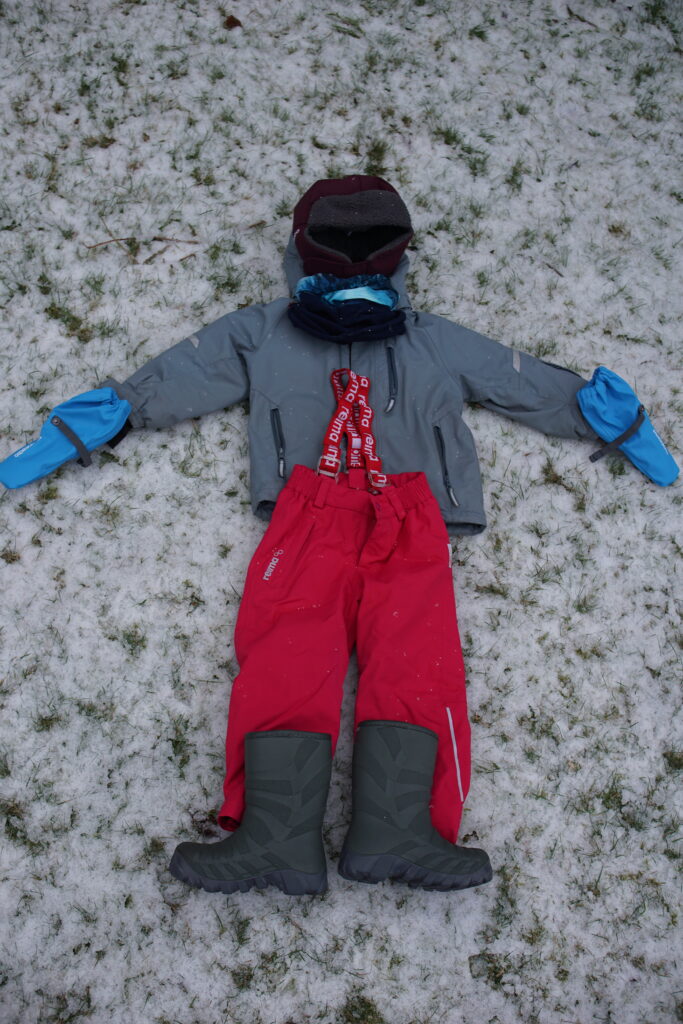

To summarise, PU fabric is best for waterproofing and easy-cleaning, so it is fantastic for nursery for most of the year. However, in the coldest conditions, I just don’t think these garments are as warm as a technical winter jacket with a DWR coating.
Here is my compromise position:
- My children wear ski-style jackets in the winter, such as the Polarn O. Pyret Kids Padded Waterproof Coat or the Reima Serkku. Yes, these are expensive. This is one area where I think it is worth choosing a quality brand, and I would (and have) chosen a second hand jacket over a budget new jacket. I’ve written about buying outdoor gear second-hand separately. I look for adjustable cuffs, peaked hoods, good neck coverage, and accessible pockets for gloves.
- Most days, my children wear fleece-lined PU dungarees for nursery, such as Playshoes or Lidl. Dungarees are the item that tends to get the muddiest, so this is where wipe-clean is the most useful! On very cold days, they wear insulated ski trousers (salopettes). At the moment, I don’t have a particular recommendation for salopettes specifically for outdoor nursery. We have tried some Reima salopettes with optional braces but found the waistband tight and restrictive when worn with multiple layers. The Spotty Otter waterproof down dungarees are incredibly warm and comfortable, but have been discontinued, and are too nice for nursery! We have tried some Helly Hansen salopettes with an older child that might be suitable – check out this review for further details.


Hats and Neckwarmers


Some sort of neck-warmer is essential for preventing heat loss. I really like the Buff Polar neck-warmers which are half fleece and half jersey. These can be worn around the neck or pulled up around the head like a balaclava. We also have an H&M wool collar which is very cosy, and some wool balaclavas. My children sometimes get irritated by a balaclava, but they are nice on windy days. The Polarn balaclava is much more fitted than the H&M balaclava. The sizing is mad on the H&M balaclavas (generally huge), but they are a good budget option.


My top recommendation for hats would be the Didriksons Biggles Hats. These are waterproof and fleece lined, with a pop-out brim for wet weather and fantastic ear coverage. I find them so practical for small children in a nursery setting, and particularly good for children who dislike wind in their ears.
Gloves


Gloves are the hardest thing to get right, at least for me! Children want to be able to use their hands, and will get frustrated and take gloves off if they can’t play properly. Five-finger gloves provide more dexterity but are a complete pain to put onto small children. Then there is the under-or-over-coat question! Once they are dressed, it has to be over-the-coat, and not all gloves stay on well when pulled over the coat.
I’ve asked outdoor practioners and friends for recommendations several times, and here is what I now send in:
- Go-to glove set up: Didrikson Pileglove Galon Mitts over a thin 5-finger knit liner glove. The waterproof outer mitt is for walking around, or general climbing and gross motor play. The child takes it off for fine-motor play, but can manage most things with a thin knit glove on. Of course, these gloves get wet and dirty, so I send in 3-4 pairs for the day.
- Back up gloves: I also send a pair of insulated ski-gloves for a warm-up if they are getting cold hands
In general, I send lots of pairs of gloves in, and then my child and the practitioners can pick what is most appropriate for the activity and the weather.
I also label gloves as conspicuously as possible, and pick distinctive and bright colours so that they are noticed when dropped or left in the woods. I actually often sharpie marker the child’s name on the outside of the gloves.
I’ve written a separate post reviewing the various styles and brands of gloves that we own, including some experiments.
Footwear
For socks, we tend to use a thin wool-blend sock as a liner sock. H&M do 4-packs for a reasonable price, which wash well on delicates. I embroider coloured dots on the toes to distinguish between sizes.
The kids then have a thick ski-type sock on top. We have some Icebreaker socks and some Britwear wool-blend socks from Amazon. The Icebreaker socks look slightly more technical (in terms of shaping, different zones, etc). But the Britwear socks do the job, they wash well, and keep my children’s feet warm. They also seem to adapt quite well to a range of foot sizes. As with H&M, I’d love to have some more colour choices to help distinguish between different sizes.


For winter boots, my go-to option is the Viking Ultra 2.0. I really like these snowboots, because they look and function like wellies, but they are nice and warm! You can hose off the mud in a few seconds, which is much better for nursery than a fabric-outer boot. They have good grip on the soles, and a comfy wool blend lining. I actually have a pair myself and can confirm that they are nice and warm in the snow, if you have a good thick sock on. I would say that the stiff upper edge can be a little uncomfortable on the back of the calf when they are brand new. But none of my children have complained about that, so it might just be me!
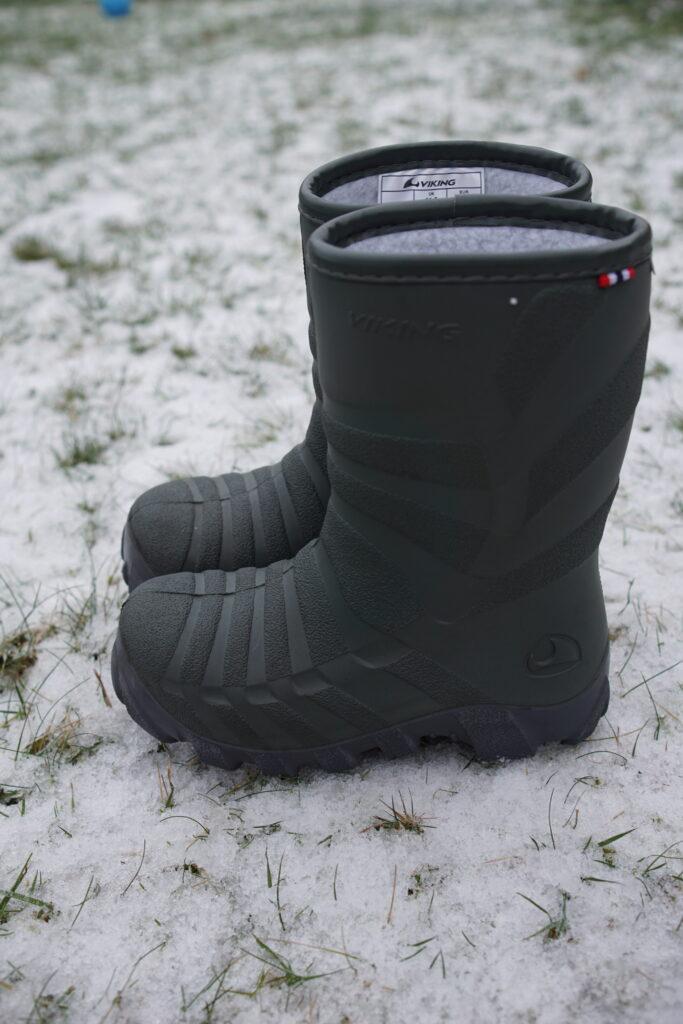

Spares
I send plenty of spares to cover colder weather, accidents and losses. I generally send in a bag:
- Several pairs of thin gloves and a pair of ski mittens (all in a ziploc bag so my child can find them quickly)
- Spare thin socks, thick socks, underwear and base-layer trousers
- Extra warm mid-layer such as a fleece or puffer jacket
Do you have a favourite recommendation for outdoor nursery winter clothing? Leave a comment below!

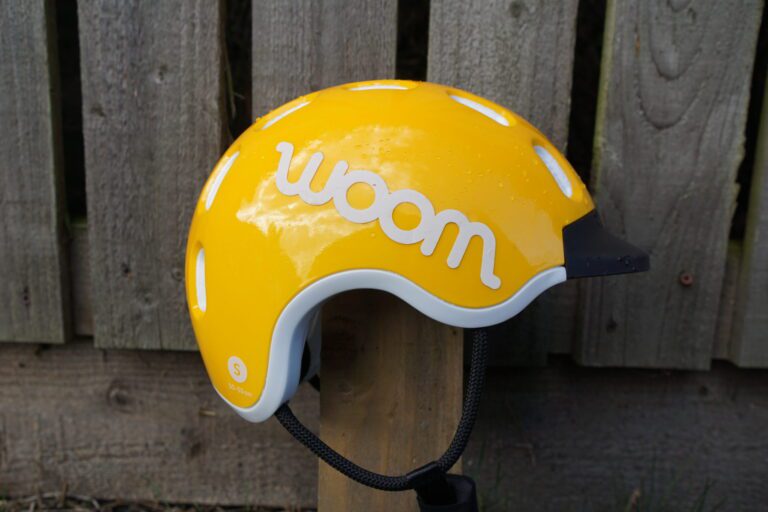
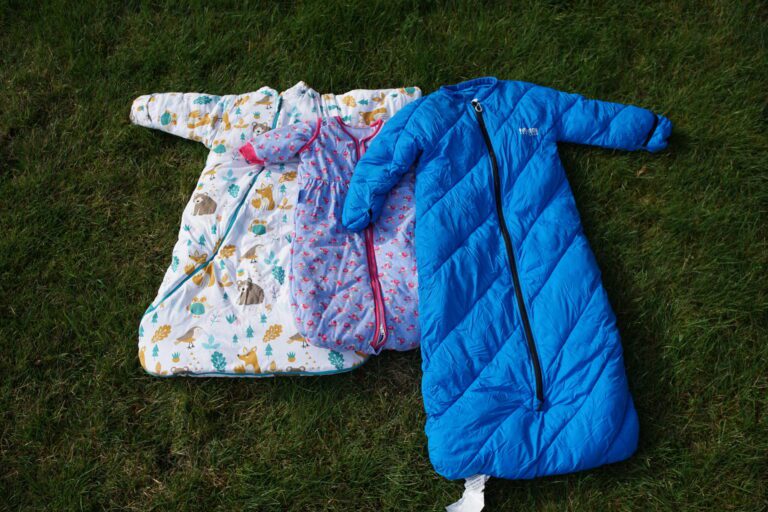
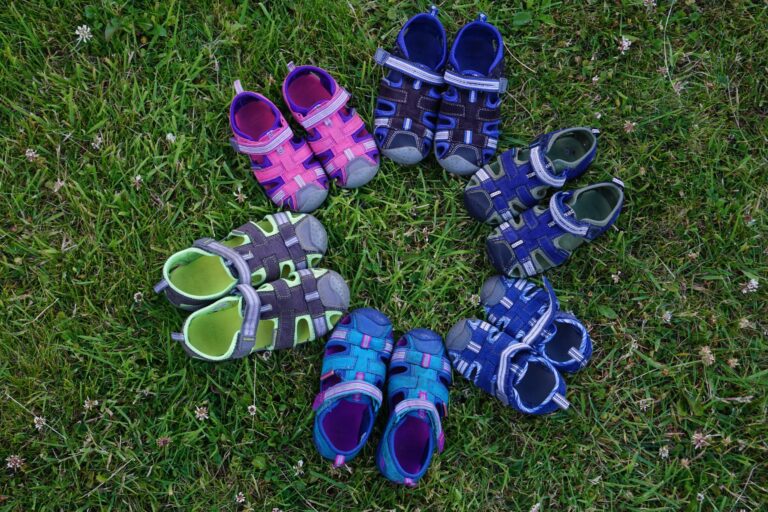
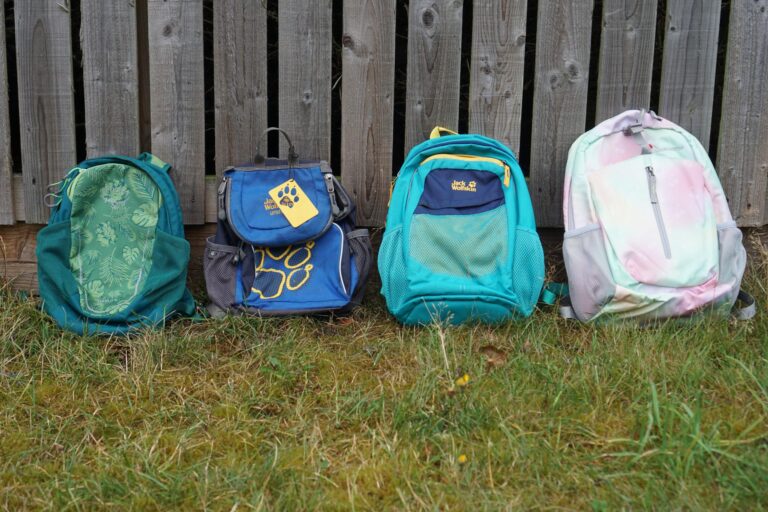
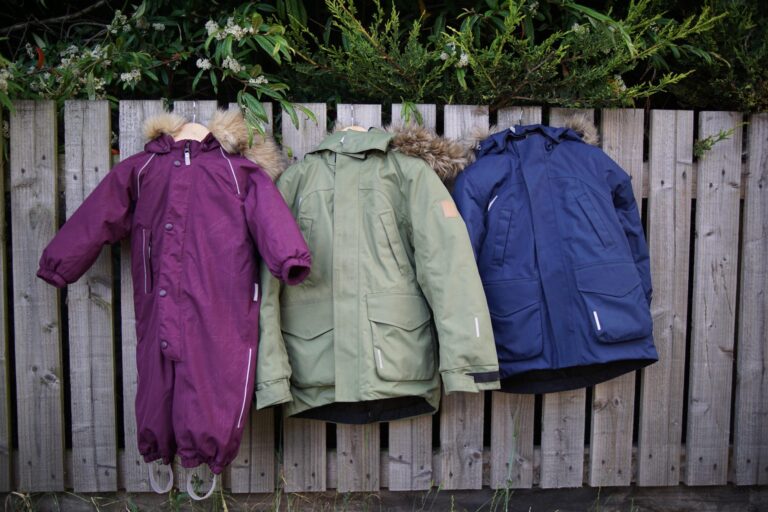
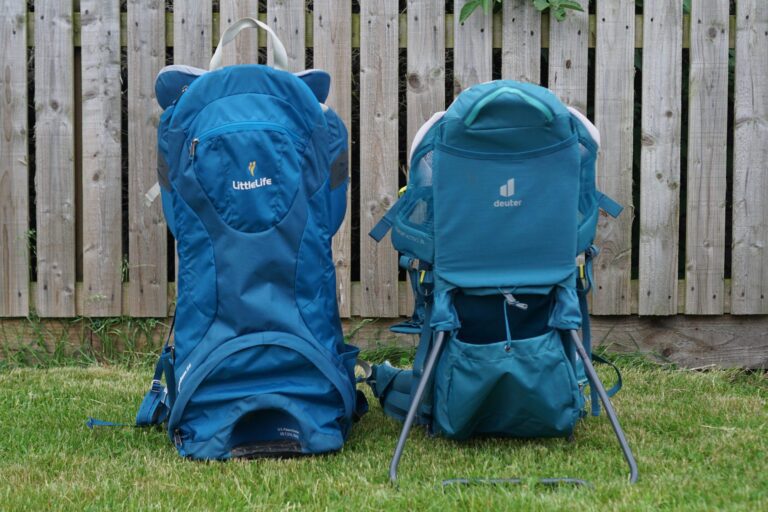
This article was a Godsend, thank you! My 3yr old daughter starts at an outdoor nursery in a few weeks and buying the right kit has been a minefield. So helpful!
Thank you so much for your kind words! I hope your daughter has a fantastic time at her outdoor nursery.